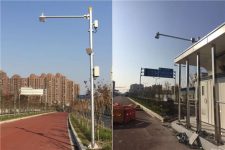
ZTE Zhilian assists Shanghai’s first BRT bus
[ad_1]
In order to actively respond to the “Opinions on Prioritizing the Development of Urban Public Transport” issued by the Ministry of Housing and Urban-Rural Development, and to implement the concepts of “people-oriented” and “transit priority”, Shanghai has planned a number of BRT lines. In June 2016, the Fengxian District Press Office announced that the construction of Shanghai’s first BRT rapid transit line has officially started, with a total length of about 33.5 kilometers, from Nanqiao Bus Station to Oriental Sports Center, passing Fengxian, Minhang, and Pudong New Districts. Three districts. From planning to project initiation to construction, Fengxian BRT project has gone through ten years.
Uncover the mystery of BRT
BRT: BusRapid Transit is abbreviated as BRT. It is a new type of public passenger transportation system between rapid rail transit and conventional public transportation. It uses large-capacity, high-performance buses and trams to run along dedicated lanes in shifts, and is dispatched by intelligent The medium-traffic rapid passenger transportation mode controlled by the system and the priority traffic signal system is usually also called the “ground subway system.”
What is the charm of BRT
BRT is a unique urban passenger transport system that opens up dedicated bus roads and builds new bus stations to realize rail transit operation services and reach the service level of light rail. Under the premise of the flexibility and low cost of ground public transportation, the high quality and high speed of the rail transit system can be realized. Compared with traditional buses, the biggest advantages of BRT are:
Exclusive BRT road space and advanced BRT signal priority traffic system bring faster vehicle operation speed and more accurate station announcement information.
Comfortable and closed BRT stations, large-capacity, low-emission, low-floor special vehicles, and station parking modes similar to rail transit, bring passengers a more high-quality and comfortable service.
Diversified vehicles, routes, platform operation information collection methods and statistical processing systems bring about a more intelligent bus dispatching system.
How does ZTE Zhilian “escort” the BRT system?
The BRT bus signal priority system is based on automobile electronic identification, using RFID UHF passive technology as a means, using an intelligent operation management system, using automatic vehicle positioning and real-time operating information, and designing and implementing intelligent signal priority algorithms. The implementation of signal priority control can increase the average speed of BRT buses by 10%~15%; reduce the travel time of BRT bus lines, reduce the delay of BRT bus intersections and the number of bus stops, and improve the stability and accuracy of BRT bus driving Rate.
Automotive electronic identification is a passive, non-contact, ultra-high frequency radio frequency technology (RFID) applied to automobiles. It is the “second-generation ID card” of automobiles. It stores information such as the license plate number in the radio frequency tag. It can realize the accurate identification of vehicle identity, and fundamentally overcome the disadvantages of traditional technical means such as geomagnetism, video, coil, etc., which cannot identify the vehicle identity, low number plate recognition rate, difficult to distinguish the authenticity of the number plate, and large influence of ambient light. The extension of networked passive radio frequency identification (RFID) in the field of smart transportation.
When a BRT bus equipped with “automotive electronic identification” passes through the road where the vehicle electronic identification road reading device is deployed, the BRT bus priority control system combines the read BRT bus label information with the vehicle reported by the vehicle detector The entry and departure information can accurately locate the license plate information and location information of the BRT bus; after the system comprehensively analyzes the operation of the BRT bus, it will send a signal to the traffic signal control machine to give priority to the application; the traffic signal control machine will take a green light after responding Extend, red light break early or insert phase, etc., implement traffic light signal adjustment to allow BRT buses to pass by priority. At the same time, in conjunction with the traffic signal control system of the traffic command center, the traffic command center control system will generate a new vehicle trajectory on the large display screen based on the car’s electronic identification information.
As a major participant in the formulation of automotive electronic marking standards by the Institute of Traffic Management Science of the Ministry of Public Security, ZTE Zhilian participated in the drafting, formulation, testing, and pilot work of the standards. ZTE Zhilian took the lead in realizing the pilot work of public transportation priority control based on automobile electronic identification technology in Wuxi and Shenzhen, effectively improving the efficiency of public transportation vehicles and passenger satisfaction. ZTE Zhilian will also rely on its own technical advantages and construction experience to continue to escort the construction and stable operation of Shanghai’s first BRT public transportation system, and to give greater play to the supportive role of automotive electronic identification technology for the convenience and benefit of the people.


[ad_2]



